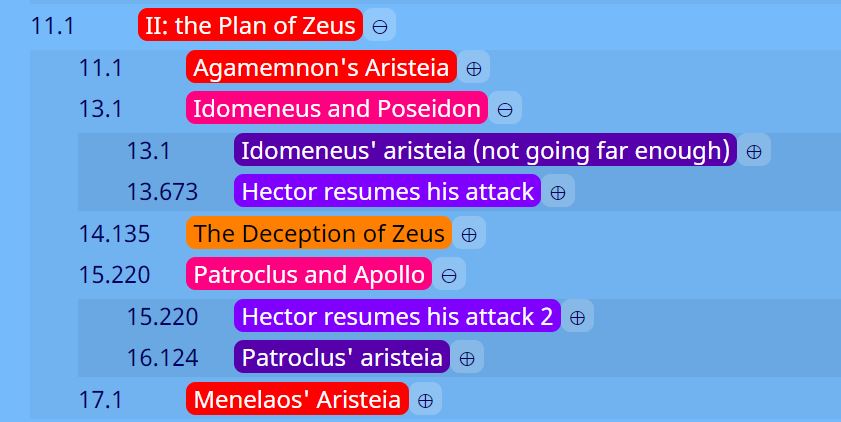The thematic map brings out some oddities in the composition. The most important and interesting one concerns the "Embassy and Assembly 2" intermezzo which at first sight is quite unlike the other E & A's. It is made up of three parts: Failure by Day, Embassy to Achilles and Success by night. The battles in the first part (book 8) seem rather redundant, while the night episode of book 10 is almost universally condemned as a fremdkörper. These two episodes add nothing to the overall story, thet could be left out and the Iliad would hardly change. Except for one thing: the relationship between the Embassy to Achilles and its context. The Embassy is very much a necessary part of the story.
First it should be noted that the end of book 7, what I call the "the people choose war" theme, is in itself an Embassy & Assembly part. It contains an Achaian and a Trojan assembly and a Trojan envoy goes to the ships with the Trojans' peace proposal. So structurally the whole of books 8, 9 and 10 could be removed and the basic plan, the Chimaera model, would still be intact. The story could move effortlessly from the end of 7 to the beginning of 11.
Secondly, there is the "somewhat odd"-ness of the Deception of Zeus episode. Brilliant as it is and also well-placed poetically as a temporary relief from all the fighting and tension, it still feels a bit off-topic. We could almost be tempted to call it a digression. Then there are the famous duals in book 9 (Homer is using a grammatical form indicating two people while there are three, apart from the two heralds (Il 9.183-98). This error appears to leave stitches visible in the patchwork. I suggest the following solution:
Originally, the Embassy to Achilles was in the place of the Deception of Zeus. This fits: the Achaians are desperate and send for Achilles. He refuses but a little later things get even worse for the Achaians and he sends Patrocles. Homer (or another poet) apparently decided that the embassy had to be moved forward. Phoenix(1), Ajax and Odysseus took over from the heralds as the main ambassadors and the scene was p(artially) re-composed. On a reason for this we can, as usual, only speculate. Perhaps he thought the poem went on for too long without Achilles appearing, perhaps he found the original sequence with Patrocles' death hard upon Achilles' refusal to fight, unsatisfactory. Too much climax in a short stretch of poem maybe so he decided to add a little water to the wine. But in the logic of the storyline the embassy would fit much better in the very centre of the poem. It must be noted that in terms of ring-composition, this fits perfectly.

So he decided to bring the Embassy to Achilles forward to a point before the beginning of the central Day of Battle. This created a problem for the poet who is always so conscious of the state of mind of the individual fighters and the armies. Like a sports coach, he knows that winning or losing in battle is for a large part "between the ears". At the end of book 7 and the beginning of book 11 the Achaians are full of self-confidence. The events of book 7 and earlier have been no reason for desperation. The embassy however obviously requires that the Achaians be in despairing mood. Later, after the failed embassy, it would be odd if the Achaians went to battle confidently as they do in book 11. So we need the Failure by Day episode (book 8) to switch from confidence to desperation and the Success by Night (book 10) to switch back to confidence. As for the structure: it should be noted that the poet is careful to weave a few assemblies into the added parts.
There are a few traces in favour of this theory besides the duals oof 9.188-. There is a repetition of themes between books 9 and 14:
- Agamemnon wanting to go home (9.17-, 14.64-)
- Odysseus "we will fight on" (9.32-), Diomedes "we will fight on" (14.128-)
- Nestor's plan "get Achilles to fight" (9.93-), Diomedes' plan: get "others" to fight (14.128-)
There is also the structure of 7.313-482 which shows it could easily be an Embassy & Assembly episode by itself.
But the role of Patrocles is not so easily reconciled. In book 9 he is with Achilles, in book 14 he is with Nestor and Eurypylos and comes back to Achilles only during the "attack on the ships" (15.220-).
The role of Ajax is quite unresolvable. Present in book 9, though not saying much, he is on the battlefield in book 14. So the two who went to Achilles originally, cannot have included Ajax. Odysseus in book 14 is free to go but he is wounded. If a wounded Odysseus had gone to Achilles, surely there should have been a mention of it. So we are forced to conclude that if there was an embassy to Achilles in book 14, it must have been an embassy by two heralds only (just as in 1.327-), Odios and Eurybates. That would at least explain the duals and also why the two heralds are there at all, since in the version we have, they are not mentioned again.
The Deception of Zeus episode does have relations to other parts: e.g the theme "death of Ares' son" (13.516-) is used again in "Zeus awake" for Hera's plan B (Il 15.104-).
All this goes to show that if the above theory, that the embassy to Achilles was originally in the place of the "Deception of Zeus" episode is to be considered, it is not about a simple cut-and-paste but a partial rewrite using both new and older material.